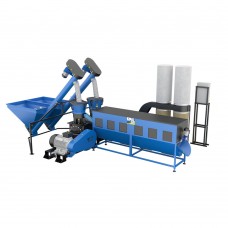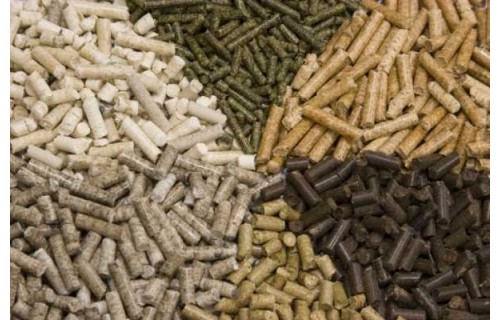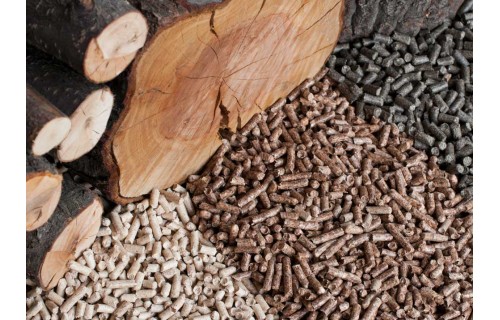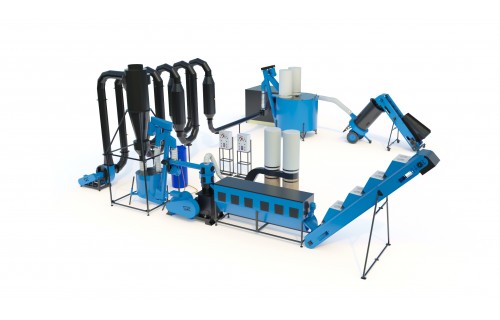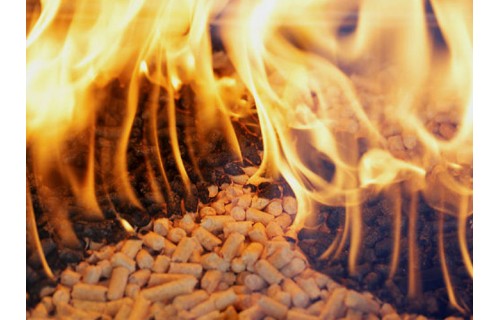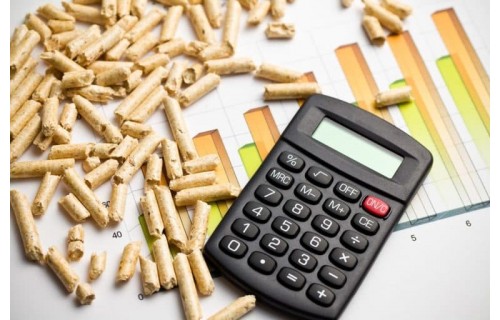TECHNOLOGY OF PRODUCTION OF PELLETS FOR SMALL OR MEDIUM ENTERPRISES
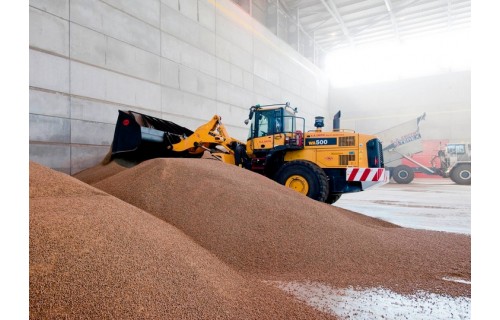
Want to present an excellent idea for opening a home, small or medium-sized enterprise - a fuel pellet production plant. Such a bet brings high profits while requiring little investment and low risk.
Energy resources have always been in high demand, especially now during the energy crisis. Therefore, a venture in the energy industry has a high chance of success and development. The pellet plant produces biofuel from pellets. Fuel pellets are produced by processing waste from the wood industry, straw, hay, sunflower husks, dry sunflower stalks and corn. Fuel pellets are an excellent alternative fuel.
The demand for pellets is increasing every day. The price of 1 tonne of pellet fuel is approximately EUR 200. In order to produce pellets, raw materials must be purchased for the plant. Raw materials for pellet production can be sawdust, small shavings, straw, sunflower husks, etc.
To produce 1 ton of fuel pellets, 7.4 cubic meters of sawdust are needed. Sawdust is worth 5 euros per cubic meter. Thus, gross profit is:
€200 - (€5 * 7.4) = €163 (approximate value)
And this is only the profit from 1 ton of alternative fuel.
After deducting all costs (electricity, wages, packaging, transport), the profitability is still over 100%. The profitability of a plant processing sawdust, etc. into fuel pellets is one of the highest in the waste processing sector.
The pellet market includes more and more consumer groups. Hard fuel pellets are actively used for heating rooms and in power plants - for generating electricity. In addition, the active use of pellets using gas generators in trucks began as an alternative to liquid fuel. The production of pellet granules is a great business idea that can be implemented with minimal investment.
The plant should produce high-quality pellets
In order to launch factory production of pellets, the production technology must be thoroughly examined. Pellets are an invention of the middle of the last century. In order to reduce the costs associated with the removal of waste from his own sawmill, Rudolf Gunnerman decided to compress sawdust directly at the plant. In this way, he reduced the amount of waste. As it turned out, compressed sawdust and shavings burn much more effectively than ordinary wood - the heat released from the pellets is 2.5 times higher. The calorific value of wood fuel depends on its carbon content. The more there is, the greater the heat dissipation. Cellulose particles of ordinary raw wood, apart from well-burning coal, still have a lot of hydrogen and oxygen, while during pressing the cellulose particles are destroyed, releasing hydrogen and oxygen in the form of gases.
Another important advantage of pellets is their flammability. When burning, a tree loses 85% of its mass in the form of volatile gases, the remaining 15% is ash. However, when burning pellets, the ash is 0.75-1.5% - it depends on the raw materials from which it was made. Moreover, fuel pellets contain 2 times less moisture than wood. When forced through the die under pressure and due to mechanical friction, the raw materials (including pellets) heat up to 110 degrees Celsius, thanks to which the humidity is halved.
Pellet production technology for a small plant
The pellet production business is a waste processing plant. Dealing with waste processing is timely, humane and, of course, profitable. Especially if you take into account the fact that waste is processed into ecological fuel. In such a plant, fuel pellets can be produced from various types of raw materials. These include: sawdust, shavings, bark, straw, sunflower husks, dry corn stalks, etc. The technical parameters of fuel pellets depend on the raw materials from which they are produced.
The price of pellets depends on the percentage of ash content - the higher it is, the cheaper the wood pellets are.
The production technology is simple. First of all, grind the raw materials to the size of fine sawdust and moisten them to 12% - 18% (depending on the raw materials). Then, the raw material is fed to a roller, flat-matrix, multi-cone or other granulating press, where, as in a meat grinder, it is squeezed out through a special lattice matrix. We obtain ready-made cylindrical pellets. The pellet length can be changed using a cutter knife that moves to a greater or lesser distance from the matrix.
The granulate is pressed thanks to a special substance in the tree, "lignin", which is released during pressing and turns into a natural glue when heated. Moreover, the tree resin burns for a long time and evenly.
Ironing equipment must be installed in the plant
Equipment costs for a fuel pellet plant are relatively low. Such pellet machines are available for both small and home ventures. They are roller or screw type. We will look at flat-die roller presses. The cost of such granulators depends on their efficiency. For example, GMK-260 (efficiency on pellets - up to 120 kg/h) can be purchased for PLN 8,272, and the power of the electric motor of such a granulator is 11 kW 380 V. There are also versions with better efficiency - over 300 kg/h, but the price is also slightly higher - PLN 23,843 (PRIME-300). The power of the PRIME-300 engine is 22 kW 380 V. Moreover, such granulators can be used to press not only fuel pellets, but also feed. The efficiency of the granulator when pelleting feed increases by at least two times compared to pellets.
To produce fuel pellets, the plant needs a shredder. For shredding straw and hay, we can offer the RD-500 Shredder.
It is also important to understand that if the pellet press is operated continuously for 3-5 months, high pressure parts and components will need to be replaced. Therefore, you should not forget to take into account the fixed costs related to the matrix and rollers - these are the main working parts of granulators. However, if pellets are produced only from soft raw materials (straw, hay), the life of the matrix and rollers more than doubles. Additionally, constant operation on the same loads will help you save electricity, which will also contribute to increasing efficiency.
ALTERNATIVE HEATING SYSTEMS INCREASINGLY CANNOT DO WITHOUT PELLETS
In any production, the main issue is always sales. The most popular application for pellet plant products is heating rooms with pellets using special boilers. But there are also other markets - pellets are used as filling for pets' litter boxes.
Pellet boilers with high efficiency up to 85% are becoming more and more popular here. They have been widely used for a long time. This type of solid fuel boilers can operate without human intervention for up to 7 days. Such work is possible thanks to the flowability of fuel pellets, which allows the furnace to be filled with solid fuel through a program controller that controls the screw feeder. The filling process is automated. The level of automation is such that the next portion of granulated wood is fed automatically from the hopper. In this way, the set temperature is maintained. The fuel pellets are ignited by a special electric heater and fan. Such stoves are also equipped with a special pellet burner, which allows for maximum use of solid fuel from pellets.
Pellet boilers are easy to maintain. They should be cleaned of ash once a month. Such furnaces are intended for home use 15-500 kW and for industrial purposes up to 2 mW. The service life of the furnaces is over 20 years. The pellet-fired furnace from the Austrian company OkoFen is shown in the photo.
Pellet stoves are a serious alternative to gas stoves, although granulated wood is not only an efficient fuel for solid fuel stoves, but also the best alternative to wood for regular stoves.
Next, examples of other ways of using pellets are provided.
Cars can be refueled with pellets
Over time, the sale of small-production factory pellets will be significantly expanded. Already in the mid-20th century, trucks worked on fuel wood. The internal combustion engine was basically the same as it is today. The cars operated on gas obtained from a gas generator through the pyrolysis of wood.
A gas generator is a device that produces flammable gases from solid fuels. This process is called pyrolysis - the breakdown of heavy molecules into lighter ones under the influence of high temperature and lack of oxygen.
We are now returning to this type of fuel for cars. But, for example, a car "Gazelle" equipped with a gas generator consumes 1 kg of wood per 1 km. This means that 100 kg of wood would have to be transported per 100 km. In this way, a significant amount of space in the car would be taken up by the gas generator and fuel for refueling. In addition, you should refuel every 50 km and accelerate the car gradually, giving the gas generator the opportunity to switch to increased power mode. All disadvantages are eliminated thanks to pellets. The flowability of the pellets allows the gas generator to be refueled automatically. The dimensions and weight of the pellet gas generator are smaller. The electronic microprocessor system monitors the car's acceleration and automatically switches on traditional fuel in the event of a sudden change in load. In addition, pellets have a higher density and calorific value, they release gas more intensively, so the number of breaks to switch to a different power of the gas generator is reduced. Dense and calorific fuel pellets require less space in the body. In addition, pellets reduce solid fuel consumption three times to 0.3 kg per 1 km. Even if gasoline is used for a short time during rapid acceleration of the car, the consumption is still more than twice as low as traditional fuel. If we drive in economy mode, we can give up petrol altogether. Then the cost of 1 km is $0.04, 1 kg of pellets = $0.11/3 (consumption per 1 km = 0.3 kg) = $0.04/km.
Another important advantage of fuel pellets is that no toxic substances are released when gas is created from wood pellets by pyrolysis. It is an ecological fuel.
Pellets are used as fuel for power plants
Pellet consumption is increasing every day, finding new applications. The European Union plans to reduce emissions of harmful substances into the atmosphere by 20% by 2020. For this purpose, it is planned to increase the use of biofuel in power plants. Yet such "green power plants" are cheaper even than solar or wind power plants.
Most large power plants in Europe are switching to granulated wood fuel. Mobile power plants powered by granulated wood fuel are emerging. More and more wood pellet stoves are being installed. And if we take into account the fact that oil and gas are constantly becoming more expensive, the use of gas generators for trucks and agricultural machines will become more and more common. Today, this is only the beginning of the development of the use of the new fuel. His need will grow every day.
It should be noted that small and family enterprises should start producing new generation fuel now and be ready for the constant increase in demand for pellets. This type of business is particularly interesting because it does not require large investments.



